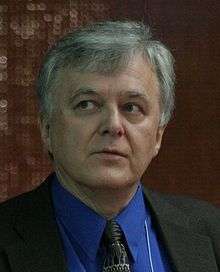Jerzy Jurka
| Jerzy Władysław Jurka | |
|---|---|
 | |
| Born |
4 June 1950 Ponikiew, Poland |
| Died |
19 July 2014 (aged 64)[1] Los Altos, California |
| Residence | United States |
| Nationality | US |
| Fields |
Chemistry Molecular Biology |
| Alma mater |
Jagiellonian University (M.Sc. Chemistry) University of Warsaw (D.Sc. Molecular Biology) Harvard University (Post-doc) |
| Known for | Contributions to understanding of transposable elements |
| Spouse | Dr. Elzbieta Jurka |
| Children |
Michael Jurka Matthew Jurka Timothy Jurka |
Jerzy Władysław Jurka (June 4, 1950 – July 19, 2014) was a Polish-American computational and molecular biologist. He served as the assistant director of research at the Linus Pauling Institute prior to founding the Genetic Information Research Institute. He collaborated with several notable scientists including George Irving Bell, Roy Britten, Temple Smith, and Emile Zuckerkandl. His Erdős number is 3, using the path through Temple Smith and Stanislaw Ulam.[2]
Research
Dr. Jurka is best known for his work on eukaryotic transposable elements (TEs), including the discovery of the major families of Alu elements.[3] He also proposed the mechanism of Alu proliferation and discovered their paternal transmission.[4][5] The majority of known types of class II TEs, or DNA transposons, were discovered or co-discovered by his team at the Genetic Information Research Institute, based on DNA sequence analysis. The first one, reported in 2001 with Vladimir Kapitonov, became known as Helitron, which is playing a major role in genomic evolution.[6] In 2006 they reported a study of a new, self-synthesizing transposable element called Polinton or Maverick, which is present many diverse eukaryotes.[7][8] More recently, Jurka and his co-workers presented a hypothesis that links the origin of repetitive families (TE families), to population subdivision and speciation based on classical concepts of population genetics.[9]
Jerzy Jurka is the founder of Repbase , which he developed since 1990 with his team and other contributors. Repbase is the primary reference database of TEs used in DNA annotation and analysis.
References
- ↑ "Jerzy Jurka". MercuryNews.com.
- ↑ The Erdős Project, "Paths to Erdős"
- ↑ Jurka J, Smith T (July 1988). "A fundamental division in the Alu family of repeated sequences". Proceedings of the National Academy of Sciences. 85 (July): 279–90. doi:10.1073/pnas.85.13.4775.
- ↑ Jurka J (March 1997). "Sequence patterns indicate an enzymatic involvement in integration of mammalian retroposons". Proceedings of the National Academy of Sciences. 94 (5): 1872–1877. doi:10.1073/pnas.94.5.1872.
- ↑ Jurka J, et al. (June 2002). "Active Alu elements are passed primarily through paternal germlines". Theoretical Population Biology. 61 (4): 519–530. doi:10.1006/tpbi.2002.1602.
- ↑ Vladimir V. Kapitonov; Jerzy Jurka (October 2007). "Helitrons on a roll: eukaryotic rolling-circle transposons". Trends. 23 (10): 521–9. doi:10.1016/j.tig.2007.08.004. PMID 17850916.
- ↑ Vladimir V. Kapitonov; Jerzy Jurka (March 21, 2006). "Self-synthesizing DNA transposons in eukaryotes". PNAS. National Academy of Sciences. 103 (12): 4540–4545. doi:10.1073/pnas.0600833103.
- ↑ Pritham EJ, Putivala T, Feschotte C (April 2007). "Mavericks, a novel class of giant transposable elements widespread in eukaryotes and related to DNA viruses". Gene. 390 (April): 3–17. doi:10.1016/j.gene.2006.08.008. PMID 17034960.
- ↑ Jurka J, Bao W, Kojima K (June 2011). "Families of transposable elements, population structure and the origin of species". Biology Direct. 6 (1): 44. doi:10.1186/1745-6150-6-44. PMC 3183009
 . PMID 21929767.
. PMID 21929767.